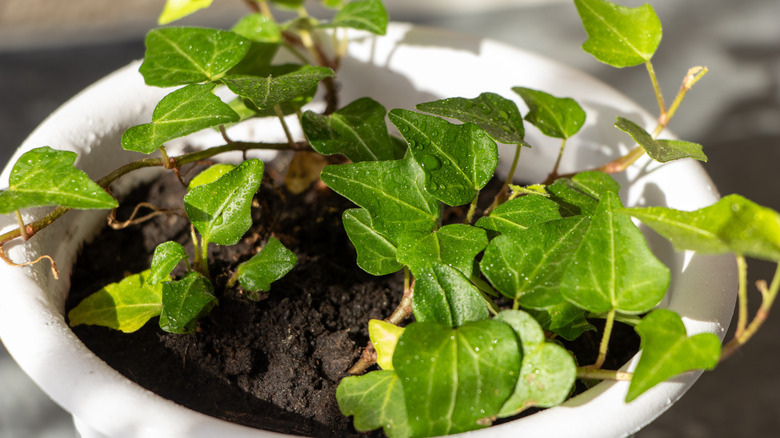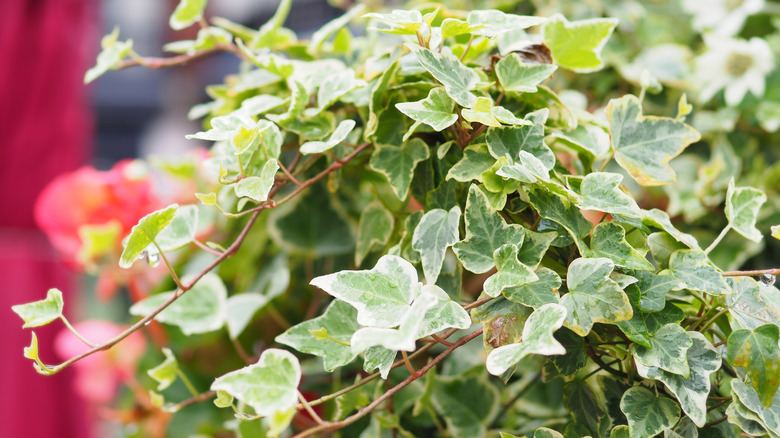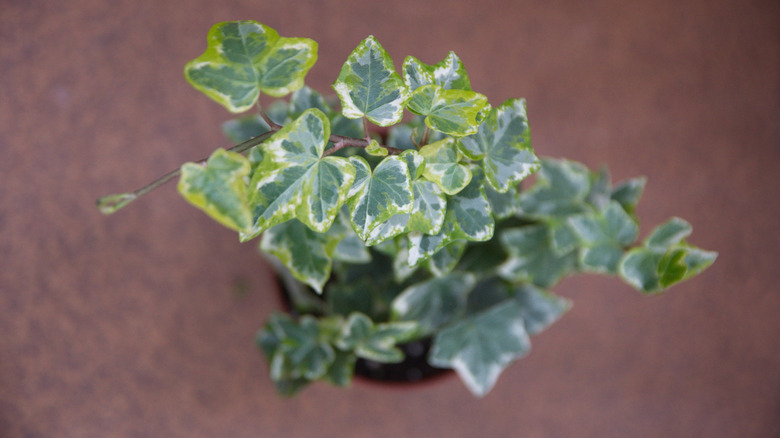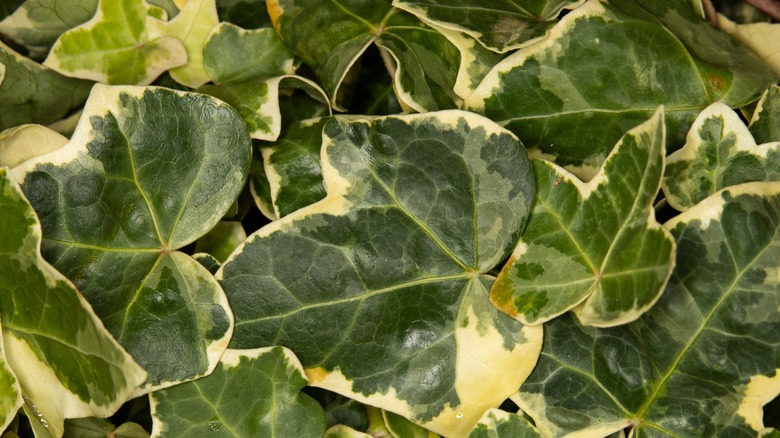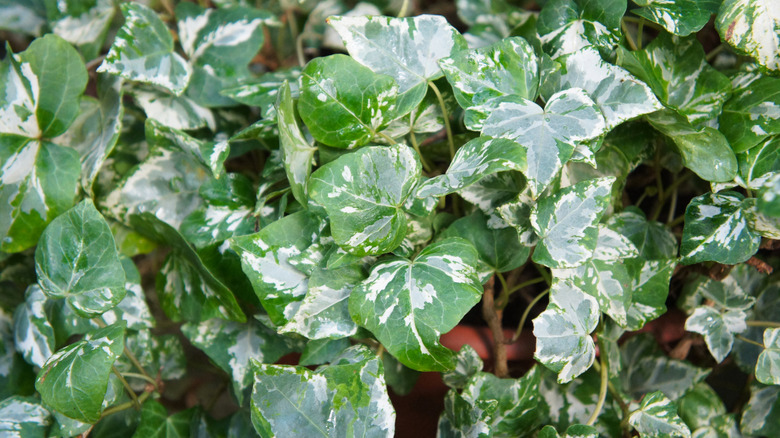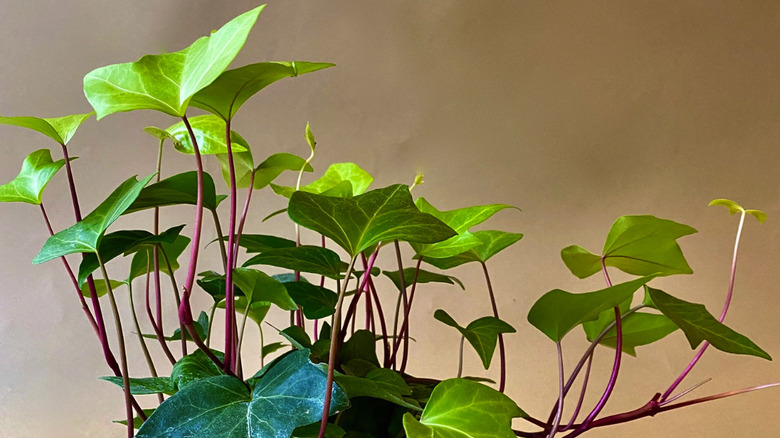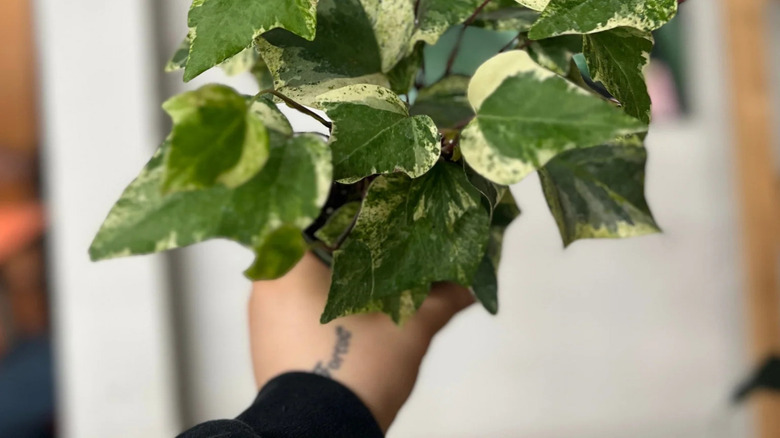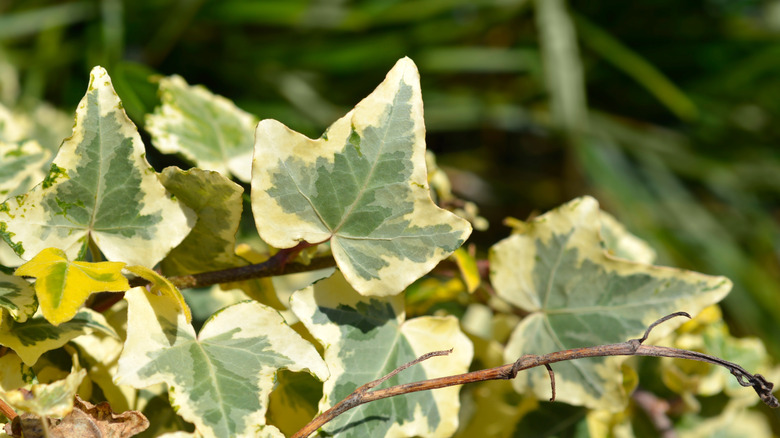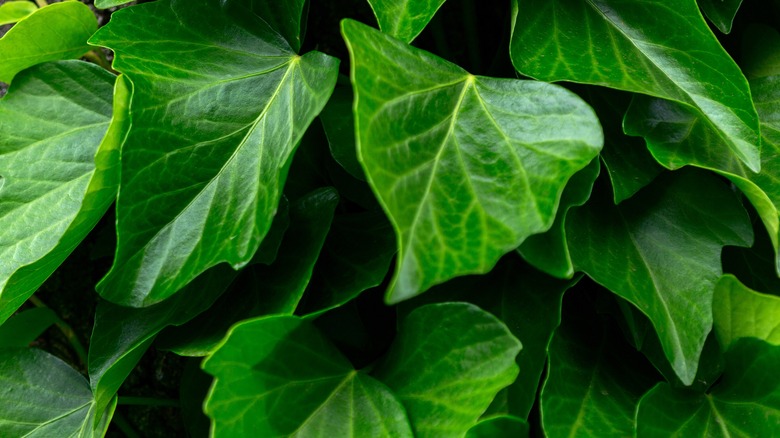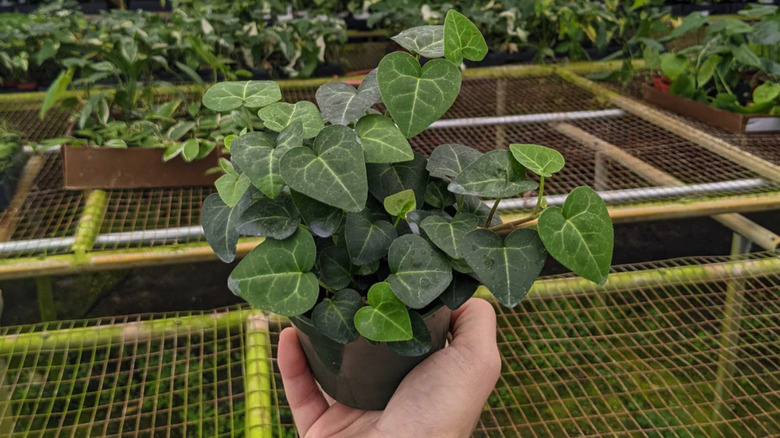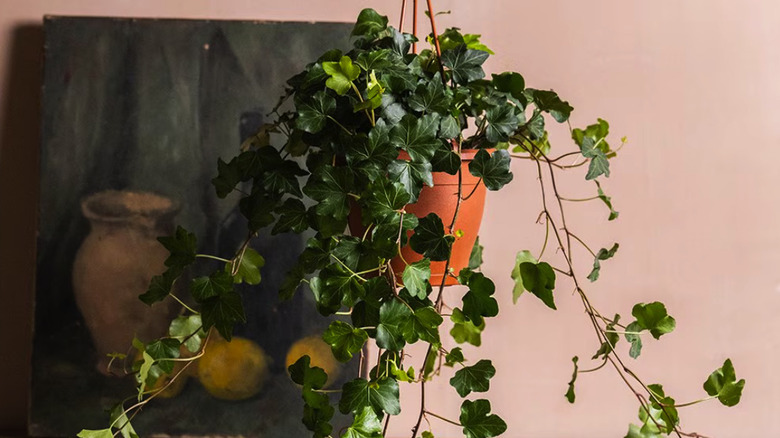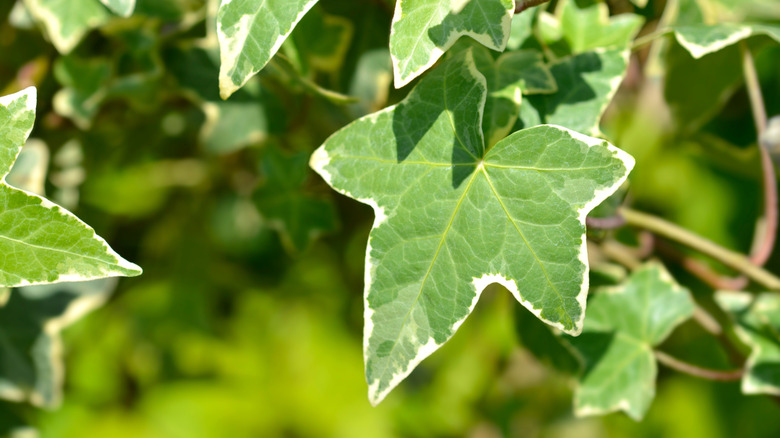18 Varieties Of Ivy That Make Excellent Houseplants
When it comes to houseplants, people commonly think of succulents, cacti, and potted flowers, but there's another type of plant that works great as a houseplant. Ivy gets a bad reputation because of its wide-spreading habits, which can make people think that it is a plant that can only be grown outdoors. But there are actually several varieties of ivy that make excellent houseplants. As long as you provide them with proper care and attention and don't make any major mistakes when growing ivy indoors, you can create a thriving environment for your plants. Not to mention, companion planting isn't just for the garden, so keep an eye out for other houseplants to pair together with your ivy to maximize the benefits in your home.
While some ivy varieties live up to the reputation of spreading wildly, certain types of ivy are particularly suited for indoor growing. A number of English ivy varieties are known to thrive in pots and hanging baskets, and can even be trained into topiary shapes. The biggest consideration for English ivy, like 'Asterisk,' 'Glacier,' and 'Kolibri,' is making sure they are getting enough light. Other varieties, like Algerian ivy, Atlantic ivy, and Persian ivy, aren't as picky about sunlight but still appreciate regular care and maintenance. It is important to note that while each of the following varieties of ivy grows well indoors, ivy is toxic when eaten by humans or pets, so use caution when growing ivy in homes with animals and small children.
'Asterisk'
Asterisk ivy (Hedera helix 'Asterisk') is a type of English ivy that is named for its shape. It features five to eight points on the leaves that spread in all directions like an asterisk. The leaves are a yellowish-green color, and the plant will produce black-colored berries, which are toxic and should not be ingested. To grow 'Asterisk' ivy, you will want to start with a container that is big enough for the roots to establish and has good drainage. Then, consider the growing environment. 'Asterisk' ivy grows best in temperatures around 60 degrees Fahrenheit, with bright, filtered sunlight.
Algerian ivy
Algerian ivy (Hedera canariensis) can withstand different conditions than English ivy varieties, especially if you are in a coastal climate. It also likes slightly warmer conditions than other varieties, with the ideal growing temperature ranging from 50 to 80 degrees Fahrenheit. While some say it can be difficult to grow in a pot because of the growth rate, others praise it for the potential for indoor growth because of its adaptability. A single plant can grow to be up to 10 feet tall and 3 feet wide. Unlike other ivy varieties, Algerian ivy prefers partial or deep shade.
'Anne Marie'
Another variety of English ivy that grows well indoors is 'Anne Marie' (Hedera helix 'Anne Marie'). It is known for being fast-growing, but it stays a manageable size of 4 feet tall and 3 feet wide. It is also sought after for the variegated leaves, which are green in the center and a creamy color at the edges. To grow best indoors, place in a well-lit room with bright or indirect sunlight. You will want to keep the soil moist, but not wet. It is recommended to water 'Anne Marie' once or twice per week when the top layer of soil feels dry.
Atlantic ivy
If you want something that isn't in the English ivy variety, you could try Atlantic ivy (Hedera hibernica), also commonly known as Irish ivy. It is a great option for indoor growing because it has a relatively small spread compared to other varieties. This ivy variety features glossy green leaves and bluish-black berries. You can expect to see a height of 10 inches and a width of up to 4 feet when you grow it indoors. It likes the same kind of lighting conditions as English ivy, with bright or indirect sunlight and moist soil that doesn't completely dry out.
'Glacier'
If you want something with a unique and interesting pattern to add to your indoor garden, 'Glacier' ivy (Hedera helix 'Glacier') is the plant for the job. This is another type of English ivy variety that features white, pale green, and dark green coloring across the leaf. Like other varieties, it will also produce small, toxic berries. They do well in small pots, about 6 inches, with loamy soil and moderate water. It does not like soggy soil. It can also withstand temperatures between 45 and 80 degrees Fahrenheit, which makes it an ideal houseplant.
'Gold Child'
Gold Child ivy (Hedera helix 'Goldchild') is another variety of English ivy that can reach about 3 feet wide when grown indoors. It has many of the same needs as other English ivy, so you will want to keep an eye on lighting and avoid watering mistakes that everyone makes when growing English ivy indoors, specifically overwatering. Only water when the top layer is damp but mostly dry. It is also a bit picky about temperatures and prefers environments that stay between 60 and 65 degrees Fahrenheit.
Himalayan ivy
Himalayan ivy (Hedera nepalensis) can be grown indoors, but is usually reserved for large spaces because it can spread relatively far. That being said, it is well-suited for household environments because of its tolerance for cooler temperatures and moderate humidity. In addition, it thrives under low to moderate light levels, which are easily achieved in most indoor environments. Himalayan ivy typically features elongated, leathery leaves that are dark green and glossy. You can expect vines to keep climbing as long as you give them vertical support, up to 20 feet in some cases. Keep the soil consistently moist but avoid leaving it wet.
'Kolibri'
'Kolibri' ivy (Hedera helix 'Kolibri') is a compact variety of English ivy that is commonly valued for the stunning variegated color. The plant features a smaller leaf size and slower growth rate, making it particularly suitable for small spaces such as desktop planters. 'Kolibri' is also used in home office environments because it has a high adaptability to indoor air quality. It thrives in bright, indirect light with moderate humidity and a growing temperature between 60 and 80 degrees Fahrenheit. Water when the top inch of soil feels dry.
'Mini Adam'
For a truly small houseplant variety of ivy, consider the 'Mini Adam' (Hedera helix 'Mini Adam'), which is a miniature variety of English ivy. It loves the sun but doesn't want direct light, so place it somewhere with bright, indirect light. People generally like 'Mini Adam' because of the small, variegated leaves and the cascading growth in hanging pots. It prefers temperatures to be above 60 degrees Fahrenheit. You can expect to water it once per week when the topsoil is dry.
'Neon'
A more colorful variety of Algerian ivy is the Neon Algerian ivy plant (Hedera canariensis 'Neon'), which is recognized for its bold, chartreuse foliage. It grows comfortably indoors, but Algerian ivy species tend to grow more vigorously than English ivy, so it may require a bit more maintenance, including regular pruning. Like other Algerian ivy varieties, 'Neon' grows best in partial shade and warm temperatures between 50 and 70 degrees Fahrenheit. However, unlike other ivies, it has a strong tolerance to variable moisture levels, making 'Neon' a good choice for indoor gardeners who are still perfecting their watering routine.
'Marble'
If you are looking for an ivy with bold characteristics, 'Marble' Algerian ivy (Hedera canariensis 'Marble') has stunning, large leaves that are marbled with white, cream, and soft green. While it grows quickly compared to other varieties, it still remains manageable indoors, as long as you keep up with a pruning schedule. You don't want to place it directly in the sunlight, but a well-lit room with indirect or filtered light is perfect. 'Marble' doesn't like wet soil, so take care to only water when the soil is no longer moist on top.
'Marengo'
Another popular indoor ivy option is Marengo ivy (Hedera canariensis 'Gloire de Marengo'), which is famous for its dramatic gray-green leaves with creamy white edges. As a matter of fact, it has been used as a houseplant for generations because it grows so well in indoor environments, but it can reach over 10 feet tall when fully grown with support. It can grow in full sun or partial shade, so it is suitable for almost any room with windows. You can expect to water your Marengo ivy up to twice per week, as long as the soil's surface dries out.
Persian ivy
One of the largest-leaved options that does well as a houseplant is Persian ivy (Hedera colchica), but it generally requires pruning to keep it at a manageable height. When left alone, it can grow to be between 30 and 70 feet tall. It is best to keep your Persian ivy out of direct sunlight to prevent leaf scorching. It will do fine in indirect light or even deep shade, making it suitable for any indoor space, except southern-facing windows. It prefers soil that is rich in organic matter and can tolerate a range of moisture levels but should still have good drainage.
'Shamrock'
'Shamrock' ivy (Hedera helix 'Shamrock') was named for the plant's resemblance to shamrocks with a tri-lobed leaf and bright green color. It is a compact variety of ivy that works well in tabletop planters, terrariums, and hanging baskets. It has the same requirements needed to successfully grow any English ivy variety, except sunlight. This is another feature that makes it particularly well-suited for indoor growing because it is highly adaptable to light conditions. This is one of the few varieties that can tolerate almost any light conditions, from full sun to full shade.
'Starling'
While many ivy varieties are popular for their light colors, 'Starling' Ivy (Hedera helix 'Starling') is popular for the deep green, pointed leaves that have a dramatic appearance. It will also produce black berries that are toxic. It is known for producing dense, compact foliage that can be trained for indoor topiaries. This is yet another variety of English ivy that prefers consistent moisture, good airflow, and bright light.
'Sweetheart'
'Sweetheart' ivy (Hedera helix 'Sweetheart') is yet another English ivy that is beloved for its charming heart-shaped leaves. It is commonly used for romantic decorations such as wedding decor, as well as indoor arrangements. Beyond the leaf shape, it is admired for the cascading, trailing growth. It appreciates a room filled with bright light and moist, but not wet, soil conditions. It does particularly well in rooms with an east- or north-facing window.
'Wonder'
The last variety of English ivy on the list is known as 'Wonder' (Hedera helix 'Wonder'). This plant features deep green, ruffled or lacy leaves that grow on trailing vines. This variety doesn't need quite as much light as other English ivy varieties, so you can place it in almost any corner of the house and still see steady growth. However, it still doesn't like wet soil, so pots with good drainage are a must. You can spray 'Wonder' leaves with water because it likes higher humidity levels, but doesn't need extra water in the soil.
'Yellow Ripple'
Yellow Ripple ivy (Hedera helix 'Yellow Ripple') stands out with its scalloped leaves and bright yellow-green variegation. The leaves are rippled at the edges, hence the name 'Yellow Ripple.' It generally prefers brighter light than other types of ivy, but it can withstand partial shade, making it great for a variety of indoor growing spaces. It is a short, trailing ivy that works great in pots, or you could use it as a hanging plant door alternative to connect small spaces.


